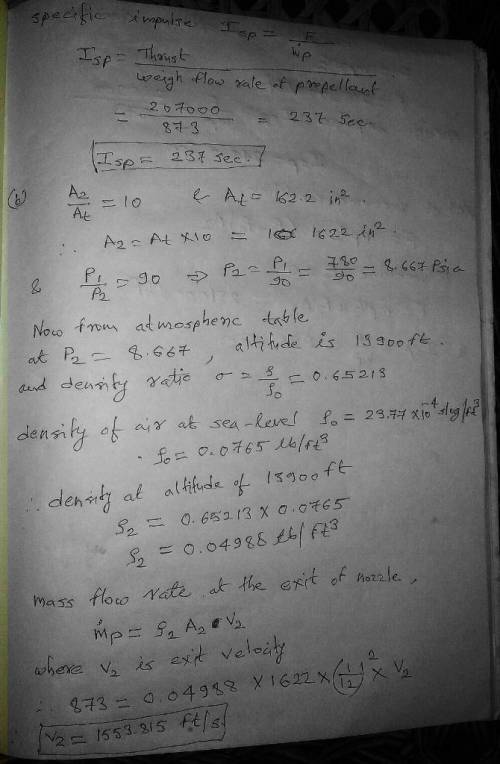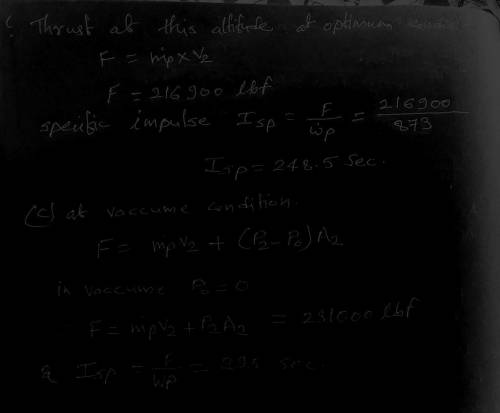
Engineering, 02.09.2020 04:01 zanestone12
For a solid propellant rocket motor with a sea level thrust of 207,000 lbf, determine: (a) the (constant) propellant mass flow rate and the specific impulse I at sea level, (b) the altitude for optimum nozzle expansion as well as the thrust and specific impulse at this optimum condition, and (c) at vacuum conditions. The initial total mass of the rocket motor is 50,000 Ibm and its propellant mass fraction is 0.90. The residual propellant (called silvers, combustion stops when the pressure falls below the deflagration limit) amounts to 3% of the burnt propellant. The burn time is 50 seconds, the nozzle throat area (4) is 164.2 in2 and its area ratio (A/A) is 10. The chamber pressure (pi) is 780 psia and the pressure ratio (pi/p2) across the nozzle is taken as 90.0. Neglect any start/stop transients and use the altitude data attached.
a) m = 873 lbm/sec, 237 sec.
b) 13.900 ft, F-216.900 lof. 1,-248.5 sec.
c) F = 23 1,000 lbf Isp = 295 sec. 2 0.

Answers: 2
Another question on Engineering

Engineering, 04.07.2019 18:10
Water in a partially filled large tank is to be supplied to the roof top, which is 8 m above the water level in the tank, through a 2.2-cm-internal-diameter pipe by maintaining a constant air pressure of 300 kpa (gage) in the tank. if the head loss in the piping is 2 m of water, determine the discharge rate of the supply of water to the roof top in liters per second.
Answers: 3

Engineering, 04.07.2019 18:10
Calculate the bore of a cylinder that has a stroke of 18 inches and an extension time of 6 seconds at a flow rate of 4 gal/min.
Answers: 3

Engineering, 04.07.2019 18:20
Select any two (2) areas of applications of chain-drive. (clo4) a)-permanent lubrication necessary b)-hydraulic forklift truck operation c)-rigging and heavy moving materials d)-relatively high maintenance costs e)-costlier than belt drives
Answers: 2

Engineering, 04.07.2019 18:20
Avolume of 2.65 m3 of air in a rigid, insulated container fitted with a paddle wheel is initially at 264 k, 5.6 bar. the air receives 432 kj by work from the paddle wheel. assuming the ideal gas model with cv = 0.71 kj/kg • k, determine for the air the amount of entropy produced, in kj/k
Answers: 2
You know the right answer?
For a solid propellant rocket motor with a sea level thrust of 207,000 lbf, determine: (a) the (cons...
Questions















Computers and Technology, 16.10.2019 05:30










